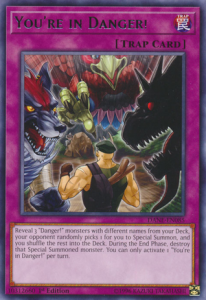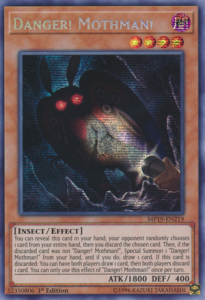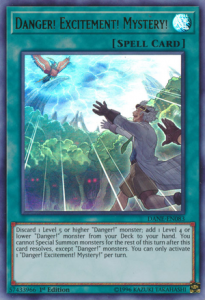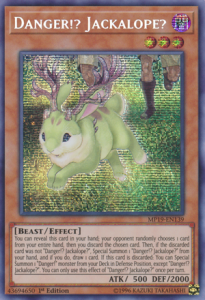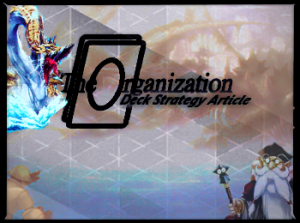Searching for the all-elusive cryptids? Bring a calculator along and this might just guide you on your expedition into Danger!
Danger! 101:
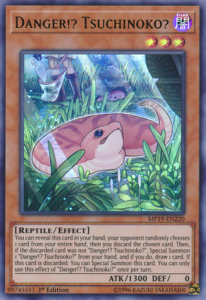 Welcome to my first CDS article highlighting the Danger! archetype. Debuting as a TCG premiere theme, this DARK archetype features an array of cryptids that force the opponent to interact with you as you make your plays – it’s the closest to a social experiment for Yu-Gi-Oh that we will ever get. Each one shares a common effect, reveal it in your hand to make your opponent pick a random card in your hand to discard. If they don’t discard the monster you revealed, you get to Special Summon it and draw a card. They each also have a different effect that activates when they are discarded. If you’ve lived under a rock and have yet to experience the joy of playing with or against these monsters, you can think of them as modern Dark World with built-in discard capabilities, but if you’re me, you’ve always wanted to figure out how to exploit them as a cohesive archetype.
Welcome to my first CDS article highlighting the Danger! archetype. Debuting as a TCG premiere theme, this DARK archetype features an array of cryptids that force the opponent to interact with you as you make your plays – it’s the closest to a social experiment for Yu-Gi-Oh that we will ever get. Each one shares a common effect, reveal it in your hand to make your opponent pick a random card in your hand to discard. If they don’t discard the monster you revealed, you get to Special Summon it and draw a card. They each also have a different effect that activates when they are discarded. If you’ve lived under a rock and have yet to experience the joy of playing with or against these monsters, you can think of them as modern Dark World with built-in discard capabilities, but if you’re me, you’ve always wanted to figure out how to exploit them as a cohesive archetype.
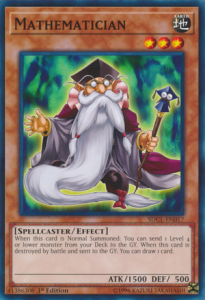 WARNING: As you might have guessed from the title, this article will dive into the scariness of math. This still follows the normal formula of archetype introduction, sample decklist, and tech options, but along the way you will find math sections denoted by [Math Warning] and [Math Over]. These sections were designed to work through the card economy of the Dangers, so I hope some of you find that interesting to read. As some folks are scared of math following traumatic experiences with the subject at school, I figured I would separate out the Math dangers from the Danger dangers, so feel free to take the dangerous path of mathematics or the easy road through this article.
WARNING: As you might have guessed from the title, this article will dive into the scariness of math. This still follows the normal formula of archetype introduction, sample decklist, and tech options, but along the way you will find math sections denoted by [Math Warning] and [Math Over]. These sections were designed to work through the card economy of the Dangers, so I hope some of you find that interesting to read. As some folks are scared of math following traumatic experiences with the subject at school, I figured I would separate out the Math dangers from the Danger dangers, so feel free to take the dangerous path of mathematics or the easy road through this article.
[Math warning]
 Let’s talk numbers – as a mathematician, I love probability and calculating card advantage, so let’s talk about the first effect of a Danger. Assuming you only have 1 copy of the Danger in hand you reveal, an opening hand will give your opponent a 20% chance of hitting the Danger! and an 80% chance of hitting something else. This means you have an 20% chance of inherently going -1 off of the first effect, and a 80% chance of going even. We thus can treat this as being a “-0.2” in card advantage, as the overall outcomes will trend toward that amount over time. Now this amount shifts depending on your cards in hand, as if you only have 2 cards in hand when you activate the first Danger effect, your opponent would have a 50% chance of hitting the Danger! This would result in a “-0.5” in card advantage.
Let’s talk numbers – as a mathematician, I love probability and calculating card advantage, so let’s talk about the first effect of a Danger. Assuming you only have 1 copy of the Danger in hand you reveal, an opening hand will give your opponent a 20% chance of hitting the Danger! and an 80% chance of hitting something else. This means you have an 20% chance of inherently going -1 off of the first effect, and a 80% chance of going even. We thus can treat this as being a “-0.2” in card advantage, as the overall outcomes will trend toward that amount over time. Now this amount shifts depending on your cards in hand, as if you only have 2 cards in hand when you activate the first Danger effect, your opponent would have a 50% chance of hitting the Danger! This would result in a “-0.5” in card advantage.
So why would so many competitive players use Danger! monsters if you are theoretically losing card advantage to activate their first effect? Well, the above math changes if your opponent happens to hit a card that itself can provide card advantage when discarded. So, now if a card provides a +1 when discarded, you can think of the entire exchange as a potential net positive in card advantage. Going back to our card advantage numbers, for a standard opening hand you get “+0.8” in advantage to the “+0.5” case of two cards. It is only an even trade in total card advantage if you discard the revealed Danger itself (and it has a card advantage effect when discarded). I will be revisiting these math calculations throughout the article, so feel free to continue reading the sections or skipping them, as your heart desires.
[Math Over]
Advantage Dangers
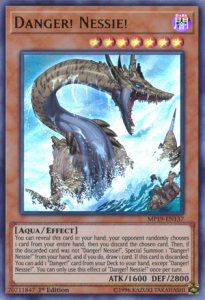 Even though the archetype may share the first effect, it comes down to the second effect that stratifies the Dangers into a number of tiers or categories. The first tier I refer to as the ‘Advantage Dangers,’ as they give you card advantage despite any prior setup when discarded. These should be familiar to everyone as they are the three Danger! monsters currently at home on the Forbidden/Limited List. Danger! Nessie! adds a Danger! card to the hand when discarded, Danger!? Jackelope? Special Summons a Danger! from Deck, and Danger!? Tsuchinoko? Special Summons itself. These three are most impactful Danger monsters because inherently they always provide an even trade in card advantage off of their first effect. Best case scenario is that your opponent discards another one of your cards that wanted to be in the GY anyways.
Even though the archetype may share the first effect, it comes down to the second effect that stratifies the Dangers into a number of tiers or categories. The first tier I refer to as the ‘Advantage Dangers,’ as they give you card advantage despite any prior setup when discarded. These should be familiar to everyone as they are the three Danger! monsters currently at home on the Forbidden/Limited List. Danger! Nessie! adds a Danger! card to the hand when discarded, Danger!? Jackelope? Special Summons a Danger! from Deck, and Danger!? Tsuchinoko? Special Summons itself. These three are most impactful Danger monsters because inherently they always provide an even trade in card advantage off of their first effect. Best case scenario is that your opponent discards another one of your cards that wanted to be in the GY anyways.
As a tier, these Dangers provide the backbone for your deck. If consistency was your only consideration, these could always be the Danger you reveal from your hand. This is the case, because it is always safe to activate them. Since these all provide even advantage at worst, you will never lose card advantage from revealing one from this tier.
Conditional Dangers
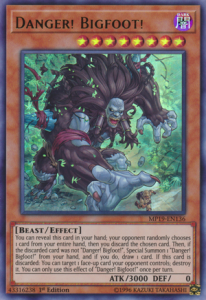 The second tier of Danger!, called ‘Conditional Dangers’ in this article, are those that provide advantage with proper setup or conditions. So another way of thinking of them is that they can be Advantage Dangers, but only in certain situations. These Dangers are sometimes used as supporting cast members for other strategies, but are more used due to their Levels than anything else. This tier includes Danger! Bigfoot! which destroys a face-up card when discarded, Danger! Thunderbird! which destroys a set card, Danger! Chupacabra! which Special Summons a Danger! from GY, and Danger! Mothman! which lets both players draw a card then discard a card. These four Dangers serve multiple roles, but they can be best described as your extenders and disruption options.
The second tier of Danger!, called ‘Conditional Dangers’ in this article, are those that provide advantage with proper setup or conditions. So another way of thinking of them is that they can be Advantage Dangers, but only in certain situations. These Dangers are sometimes used as supporting cast members for other strategies, but are more used due to their Levels than anything else. This tier includes Danger! Bigfoot! which destroys a face-up card when discarded, Danger! Thunderbird! which destroys a set card, Danger! Chupacabra! which Special Summons a Danger! from GY, and Danger! Mothman! which lets both players draw a card then discard a card. These four Dangers serve multiple roles, but they can be best described as your extenders and disruption options.
As a tier, these dangers can provide a bit more power to the deck. Consistency alone doesn’t win games, so these cards let you turn power plays to get the duel into your favor. In situations where their effect(s) would be able to activate, these could be the Danger you reveal from your hand, as you still guarantee even card advantage in specific circumstances. For example, if your opponent controls no cards, you should not be activating Bigfoot before you activate a Tsuchinoko. Or if you don’t have a specific card in hand that provides advantage when discarded, you should not activate Mothman before Nessie.
Potential Danger
 I refer to the third tier of Danger! as the ‘Potential Danger’, since there is only one of them, and it doesn’t immediately provide card advantage itself. This tier consists of Danger! Ogopogo! which sends any Danger! card from your deck to the GY when discarded. This tier is very much interwoven with the Danger support cards, as the two with GY effects can quickly make up the lost card advantage simply by discarding one of your Advantage Dangers. I like to define this as a tier in the hope that one day it will gain another cryptid member, but we shall see if Danger! ever receive future monster support.
I refer to the third tier of Danger! as the ‘Potential Danger’, since there is only one of them, and it doesn’t immediately provide card advantage itself. This tier consists of Danger! Ogopogo! which sends any Danger! card from your deck to the GY when discarded. This tier is very much interwoven with the Danger support cards, as the two with GY effects can quickly make up the lost card advantage simply by discarding one of your Advantage Dangers. I like to define this as a tier in the hope that one day it will gain another cryptid member, but we shall see if Danger! ever receive future monster support.
The last Danger monster, Danger! Dogman, remains off my tierlist entirely because he does not offer any advantage or delayed advantage, thus he is not worthy of consideration for valuable deckspace. It’s off to the doghouse with him.
[Math 2 warning]
 Let’s factor back in math to look at the correct order to reveal your Dangers. As I hinted briefly, you as a player may need to make a decision as to how you want to pilot the Dangers. Do you want to minimize risk by driving for consistency? Or do you want to maximize potential gains at higher risk? To address these questions and to assess your own playstyle, consider the following scenario: You draw an opening hand of Tsuchinoko, Nessie, Bigfoot, Chupacabra, and Ogopogo. Which would you reveal first? Click the spoiler to dive into the math behind what could happen.
Let’s factor back in math to look at the correct order to reveal your Dangers. As I hinted briefly, you as a player may need to make a decision as to how you want to pilot the Dangers. Do you want to minimize risk by driving for consistency? Or do you want to maximize potential gains at higher risk? To address these questions and to assess your own playstyle, consider the following scenario: You draw an opening hand of Tsuchinoko, Nessie, Bigfoot, Chupacabra, and Ogopogo. Which would you reveal first? Click the spoiler to dive into the math behind what could happen.
Spoiler
 If you chose Tsuchinoko: 20% chance to just summon the discarded Tsuchinoko. 20% chance of discarding Nessie (-1), summoning Tsuchinoko, drawing a card (+1), then searching a Danger card (+1). 20% chance of discarding Ogopogo (-1), summoning Tsuchinoko, drawing a card (+1), then sending a Danger card to GY. 40% chance of discarding a Danger that can’t activate (-1) and just drawing a new card to replace it (+1).
If you chose Tsuchinoko: 20% chance to just summon the discarded Tsuchinoko. 20% chance of discarding Nessie (-1), summoning Tsuchinoko, drawing a card (+1), then searching a Danger card (+1). 20% chance of discarding Ogopogo (-1), summoning Tsuchinoko, drawing a card (+1), then sending a Danger card to GY. 40% chance of discarding a Danger that can’t activate (-1) and just drawing a new card to replace it (+1).
Card advantage total for revealing Tsuchinoko- 0+.2+0+0+[…]+.2 = “0.4” factoring in the delayed advantage from Ogo.
 If you chose Nessie: 20% chance to just search a new Danger to replace the discarded Nessie. 20% chance of discarding Tsuchinoko (-1), summoning Nessie, drawing a card (+1), then summoning back Tsuchinoko (+1). 20% chance of discarding Ogopogo (-1), summoning Nessie, drawing a card (+1), then sending a Danger card to GY. 40% chance of discarding a Danger that can’t activate (-1) and just drawing a new card to replace it (+1).
If you chose Nessie: 20% chance to just search a new Danger to replace the discarded Nessie. 20% chance of discarding Tsuchinoko (-1), summoning Nessie, drawing a card (+1), then summoning back Tsuchinoko (+1). 20% chance of discarding Ogopogo (-1), summoning Nessie, drawing a card (+1), then sending a Danger card to GY. 40% chance of discarding a Danger that can’t activate (-1) and just drawing a new card to replace it (+1).
Card advantage total for revealing Nessie – 0+.2+0+0+[…]+.2 = “0.4” factoring in the delayed advantage from Ogo.
 If you chose Ogopogo: 20% chance to just send a Danger card to GY. 20% chance of discarding Tsuchinoko (-1), summoning Ogopogo, drawing a card (+1), then summoning back Tsuchinoko (+1). 20% chance of discarding Nessie (-1), summoning Ogopogo, drawing a card (+1), then searching a Danger card. 40% chance of discarding a Danger that can’t activate (-1) and just drawing a new card to replace it (+1).
If you chose Ogopogo: 20% chance to just send a Danger card to GY. 20% chance of discarding Tsuchinoko (-1), summoning Ogopogo, drawing a card (+1), then summoning back Tsuchinoko (+1). 20% chance of discarding Nessie (-1), summoning Ogopogo, drawing a card (+1), then searching a Danger card. 40% chance of discarding a Danger that can’t activate (-1) and just drawing a new card to replace it (+1).
Card advantage total for revealing Ogopogo – (-.2)+.2+.2+0+[…]+.2 = “0.4” factoring in the delayed advantage from Ogo.
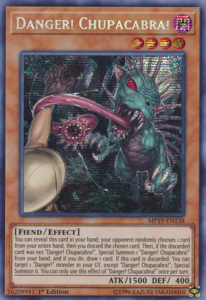 If you chose Bigfoot or Chupacabra: 20% chance to just discard the revealed Danger. 20% chance of discarding Tsuchinoko (-1), summoning Bigfoot or Chupacabra, drawing a card (+1), then summoning back Tsuchinoko (+1). 20% chance of discarding Nessie (-1), summoning Bigfoot or Chupacabra, drawing a card (+1), then searching a Danger card. 20% chance of discarding Ogopogo (-1), summoning Bigfoot or Chupacabra, then sending a Danger card to GY. 20% chance of discarding the other Danger that can’t activate (-1) and just drawing a new card to replace it (+1).
If you chose Bigfoot or Chupacabra: 20% chance to just discard the revealed Danger. 20% chance of discarding Tsuchinoko (-1), summoning Bigfoot or Chupacabra, drawing a card (+1), then summoning back Tsuchinoko (+1). 20% chance of discarding Nessie (-1), summoning Bigfoot or Chupacabra, drawing a card (+1), then searching a Danger card. 20% chance of discarding Ogopogo (-1), summoning Bigfoot or Chupacabra, then sending a Danger card to GY. 20% chance of discarding the other Danger that can’t activate (-1) and just drawing a new card to replace it (+1).
Card advantage total for revealing Bigfoot or Chupacabra – (-.2)+.2+.2+0+[…]+.2 = “0.4” factoring in the delayed advantage from Ogo.
 At first glance, this may have seemed like a trick question as any of the above options results in the same exact overall card advantage. But take a closer look at the incremental advantage of each potential scenario which adds up to the total. Where you see negatives in the string of operations indicates that some possibilities would lose you card advantage. So, to minimize the risk, it is mathematically recommended to begin with Tsuchinoko or Nessie! However, low-risk play encourages low rewards, so it is up to you as a duelist to decide if you want a greater chance of a ‘+1’ off of a Danger effect or no chance of a ‘-1’.
At first glance, this may have seemed like a trick question as any of the above options results in the same exact overall card advantage. But take a closer look at the incremental advantage of each potential scenario which adds up to the total. Where you see negatives in the string of operations indicates that some possibilities would lose you card advantage. So, to minimize the risk, it is mathematically recommended to begin with Tsuchinoko or Nessie! However, low-risk play encourages low rewards, so it is up to you as a duelist to decide if you want a greater chance of a ‘+1’ off of a Danger effect or no chance of a ‘-1’.
To get back to answering the original question, which Danger you picked for this scenario might help you to understand what kind of risk-tolerance you have as a duelist.
It’s also important to note that the scenarios and above discussion may change as the duel progresses. Playing against an archetype with a strong grind game, you may want to risk more to get the duel over with before you get out-resourced. All I’m saying is that you might have different priorities at that point; you may have better potential options. So ensure that the order you reveal your Danger! monsters is deliberate.
[Math 2 over]
Dangerous Support
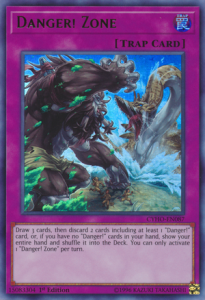 Before we can get into discussing the build for today, we also have to touch upon the cool Danger support cards that make it possible. First up is Danger! Zone – the theme’s Graceful Charity. The Trap card lets you draw 3 then discard 1 Danger card and 1 other card. If you don’t have a Danger to discard you have to shuffle your whole hand back into the deck, so don’t be the guy that uses Zone with no Dangers in hand. This should be used to trigger your Advantage Dangers if you want to significantly gain card advantage off of Zone, or you can use Conditional Dangers to disrupt your opponent during their turn!
Before we can get into discussing the build for today, we also have to touch upon the cool Danger support cards that make it possible. First up is Danger! Zone – the theme’s Graceful Charity. The Trap card lets you draw 3 then discard 1 Danger card and 1 other card. If you don’t have a Danger to discard you have to shuffle your whole hand back into the deck, so don’t be the guy that uses Zone with no Dangers in hand. This should be used to trigger your Advantage Dangers if you want to significantly gain card advantage off of Zone, or you can use Conditional Dangers to disrupt your opponent during their turn!
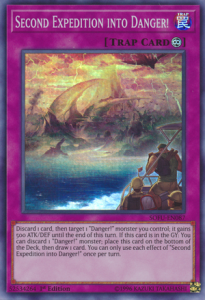 The next cards are the theme’s key support cards – Danger! Response Team boasts two key effects to support your efforts. First, this spell returns 1 Danger you control and 1 other monster on the field to the hand(s). This is great for bouncing monsters immune to destruction such as the Thunder Dragon Fusions, or it can just be used to refill your hand with multiple Dangers that you control. However, it is its second effect that’s key – when it is in the GY, you can discard 1 Danger card to return it to the bottom of your deck and draw a card. In short, pair this with any of your Advantage Dangers, and you get a +1 off of its GY effect. Second Expedition into Danger! includes the same GY effect, only since it is a Trap card, it can also be used during your opponent’s turn as a quick effect. This lets you trigger your Conditional Dangers anytime you get into a pinch, giving you more disruption capabilities. If you haven’t guessed yet, these are the two support cards you want to be sending with Ogopogo to the GY, as they let you get the extra card advantage back.
The next cards are the theme’s key support cards – Danger! Response Team boasts two key effects to support your efforts. First, this spell returns 1 Danger you control and 1 other monster on the field to the hand(s). This is great for bouncing monsters immune to destruction such as the Thunder Dragon Fusions, or it can just be used to refill your hand with multiple Dangers that you control. However, it is its second effect that’s key – when it is in the GY, you can discard 1 Danger card to return it to the bottom of your deck and draw a card. In short, pair this with any of your Advantage Dangers, and you get a +1 off of its GY effect. Second Expedition into Danger! includes the same GY effect, only since it is a Trap card, it can also be used during your opponent’s turn as a quick effect. This lets you trigger your Conditional Dangers anytime you get into a pinch, giving you more disruption capabilities. If you haven’t guessed yet, these are the two support cards you want to be sending with Ogopogo to the GY, as they let you get the extra card advantage back.
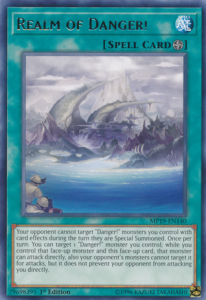 The other support cards for the theme have extremely narrow niches that make them very difficult to play. Danger! Excitement! Mystery! has potential until you realize that only 1 of the Advantage Dangers is Level 5 or higher, thus you will be relying on the same conditions for this spell as your Conditional Dangers. On the other end, Danger! Feets of Strength gives one of your dangers extra ATK and the ability to attack monsters twice, but that means you won’t want to be destroying your opponent’s monsters with your Conditional Danger effects, limiting you in that regard. Next, You’re in Danger! Special Summons directly from your deck, but since none of them have effects on the field, you have to pair this with your Response Team as a roundabout search engine. Lastly, Realm of Danger is a gimmick that lets your Danger monsters attack directly, which is admitedly neat but difficult to account for.
The other support cards for the theme have extremely narrow niches that make them very difficult to play. Danger! Excitement! Mystery! has potential until you realize that only 1 of the Advantage Dangers is Level 5 or higher, thus you will be relying on the same conditions for this spell as your Conditional Dangers. On the other end, Danger! Feets of Strength gives one of your dangers extra ATK and the ability to attack monsters twice, but that means you won’t want to be destroying your opponent’s monsters with your Conditional Danger effects, limiting you in that regard. Next, You’re in Danger! Special Summons directly from your deck, but since none of them have effects on the field, you have to pair this with your Response Team as a roundabout search engine. Lastly, Realm of Danger is a gimmick that lets your Danger monsters attack directly, which is admitedly neat but difficult to account for.
Turning to Outside Support
 Since we don’t have enough Danger support to build a full deck, that means we have to turn to other archetypes and support cards if we want to build a Danger deck. While Danger! Gren Maju was a thing in recent months at the competitive level, the deck has quickly disappeared due to its inherent inconsistencies and vulnerabilities, so this article will be focusing on building the Danger theme in a different way. That said, one of the common threads between the two is the best support card danger monsters could ask for – The Beginning of the End. This draw spell is godlike for Dangers, full stop. All you need to do is banish 5 DARK monsters from your GY to get 3 draws. It is not a hard once per turn, it doesn’t need to banish monsters with different names… it really is great. This spell not only provides draw power, but it gives the deck to continue onward after initial plays, giving it the longevity to play through disruption like Nibiru.
Since we don’t have enough Danger support to build a full deck, that means we have to turn to other archetypes and support cards if we want to build a Danger deck. While Danger! Gren Maju was a thing in recent months at the competitive level, the deck has quickly disappeared due to its inherent inconsistencies and vulnerabilities, so this article will be focusing on building the Danger theme in a different way. That said, one of the common threads between the two is the best support card danger monsters could ask for – The Beginning of the End. This draw spell is godlike for Dangers, full stop. All you need to do is banish 5 DARK monsters from your GY to get 3 draws. It is not a hard once per turn, it doesn’t need to banish monsters with different names… it really is great. This spell not only provides draw power, but it gives the deck to continue onward after initial plays, giving it the longevity to play through disruption like Nibiru.
But while Beginning provides some long term benefits, we still need to figure out what else to pair with the Dangers to benefit from their discarding. There’s a couple of options, so let’s discuss them:
- ABC: Discarding Union monsters is cool when they can be banished from GY to summon ABC-Dragon Buster, which also can discard your Dangers to trigger during the opponent’s turn. This theme also pairs well due to its affinity for link summon chains by looping the Union monsters, plus Union Hangar is a great playstarter.
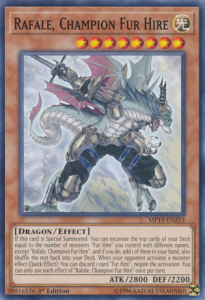 Fur Hire: Here’s the wildcard that always show up with my articles – Fur Hires. Since the Dangers sport so many different Types in their ranks, you can easily throw in a small Fur Hire engine into the deck. This engine can even be just 1 or 2 copies of Rafale, Champion Fur Hire. Simple link away 3 Dangers of different Ranks to summon Folgo, Justice Fur Hire, which can summon Rafale straight from your deck, which then lets you add the top card of your deck to the hand. The side benefit is drawing an additional card your Conditional Dangers destroy something, giving you more card advantage to work with.
Fur Hire: Here’s the wildcard that always show up with my articles – Fur Hires. Since the Dangers sport so many different Types in their ranks, you can easily throw in a small Fur Hire engine into the deck. This engine can even be just 1 or 2 copies of Rafale, Champion Fur Hire. Simple link away 3 Dangers of different Ranks to summon Folgo, Justice Fur Hire, which can summon Rafale straight from your deck, which then lets you add the top card of your deck to the hand. The side benefit is drawing an additional card your Conditional Dangers destroy something, giving you more card advantage to work with.- Blue-Eyes: Featuring a split of Level 8s and Level 1 tuners that want to be discarded, this combination of Light and Darkness can prove to be quite effective. Just make sure you anime shout as you play the original Blue-Eyes White Dragon.
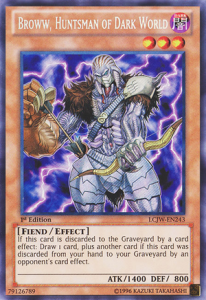 Dark World: Ah yes, the original ‘want to be discarded’ theme. While a big Danger/Dark World Hybrid can be rediculously inconsistent, you can get away with a smaller Dark World engine to just provide a couple of sweet options to hopefully discard. Remember, Mothman gives you an intheme way to ensure that you discard your Dark World cards. And if your opponent happens to include a Mothman of their own in their deck, get those second Dark World effects ready!
Dark World: Ah yes, the original ‘want to be discarded’ theme. While a big Danger/Dark World Hybrid can be rediculously inconsistent, you can get away with a smaller Dark World engine to just provide a couple of sweet options to hopefully discard. Remember, Mothman gives you an intheme way to ensure that you discard your Dark World cards. And if your opponent happens to include a Mothman of their own in their deck, get those second Dark World effects ready!- Rokket: Discarding Absorouter Dragon can be a dream, especially when it searches Rokket Synchron. This then gives you two more monsters for DARK link summons, or it unlocks Synchro Summons for your deck.
- Orcust: Wow, Quincy remembered that Orcust exist! Yes, but they’re cool and super well-known, so I’m going to leave it at this.
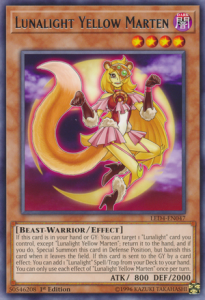 Lunalight: This theme works exceptionally well with Dangers, although their engine is quite large. This means that you would have to run slightly more Lunalights and less Dangers to get an optimal build, eliminating other potential engines for your deck. But Lunalights do provide discard outlets, gain effects when sent to the GY, and can make use of the large amount of free extra deck space that Danger brings along!
Lunalight: This theme works exceptionally well with Dangers, although their engine is quite large. This means that you would have to run slightly more Lunalights and less Dangers to get an optimal build, eliminating other potential engines for your deck. But Lunalights do provide discard outlets, gain effects when sent to the GY, and can make use of the large amount of free extra deck space that Danger brings along!- Gren Maju: As of late, this is the most competitively visible build of dangers, specifically because they actually do aim to make use of the Dangers to win the duel rather than just as a supplementary engine. With so few solo combo pieces, Danger is a great candidate for running Pot of Desires, especially when it has synergy with all the other cards banishing out the wazoo throughout the duel.
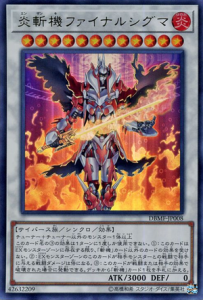 Mathmech: While not yet released to the TCG, this Mystic Fighters archetype plays rather well with the Dangers, providing an alternative win condition through a really big Synchro monster. There is also some additional synergy with Cynet Mining, as it can be used to both trigger a Danger and search your initial Mathmech. Since this article had so much mathspeak in it, figured it would be cool to also callout this math-related theme!
Mathmech: While not yet released to the TCG, this Mystic Fighters archetype plays rather well with the Dangers, providing an alternative win condition through a really big Synchro monster. There is also some additional synergy with Cynet Mining, as it can be used to both trigger a Danger and search your initial Mathmech. Since this article had so much mathspeak in it, figured it would be cool to also callout this math-related theme!
Enough chat about various engines and archetypes, let’s look at a proposed decklist already and see how it can all come together.
The Decklist:
Click to view the Interactive Decklist in the Official Card Database.
Spoiler
Monsters: 29
|| Danger! Nessie!
|| Danger!? Jackalope?
|| Danger!? Tsuchinoko?
||| Danger! Bigfoot!
||| Danger! Thunderbird!
||| Danger! Chupacabra!
||| Danger! Mothman!
||| Danger! Ogopogo!
|| Broww, Huntsman of Dark World
| Snoww, Unlight of Dark World
| Duke Shade, the Sinister Shadow Lord
| Rafale, Champion Fur Hire
|| Iron Dragon Tiamaton
| Phantom Skyblaster
Spells: 8
| Danger! Response Team
||| The Beginning of the End
|| Recurring Nightmare
|| Super Polymerization
Traps: 4
||| Danger! Zone
| Second Expedition into Danger!
Extra Deck: 15
| Mudragon of the Swamp
| Predaplant Triphyoverutum
| Starving Venom Fusion Dragon
| Salamangreat Violet Chimera
| Black Luster Soldier – Soldier of Chaos
| Borrelsword Dragon
| Curious, the Lightsworn Dominion
| I:P Masquerena
| Knightmare Cerberus
| Knightmare Phoenix
| Knightmare Gryphon
| Knightmare Unicorn
| Mekk-Knight Crusadia Avramax
| Wee Witch’s Apprentice
| Folgo, Justice Fur Hire
My Choices:
Take the fact that I went with a combination of DARK support, Super Poly, Fur Hire, and Dark World as my engines with a grain of salt as there are plenty of options available. At the end of the day, you need to pick those that match your playstyle. My playstyle revolves around generating high moments as much as possible, moments where the deck can shine standing on its own. But you might be a player who values consistent performance more. Or you might be a player that wants to be able to combo out of any potential 5-card hand you are dealt. So pick what matches you. That’s my advice on this one.
 At the end of the day, I rely upon Link summoning as the win condition. I:P Masquerena into Mekk-Knight Crusadia Avramax is pretty scary, but this deck also can easily go into Knightmare Gryphon or Borrelsword OTKs as needed. With so many high level monsters, the BLS link also can apply serious pressure to an opponent. But most of all, Dangers just let you keep playing through disruption. Your opponent has to have multiple options ready, otherwise you just keep continuing on and on until you are out of discards or hit a really bad luck streak.
At the end of the day, I rely upon Link summoning as the win condition. I:P Masquerena into Mekk-Knight Crusadia Avramax is pretty scary, but this deck also can easily go into Knightmare Gryphon or Borrelsword OTKs as needed. With so many high level monsters, the BLS link also can apply serious pressure to an opponent. But most of all, Dangers just let you keep playing through disruption. Your opponent has to have multiple options ready, otherwise you just keep continuing on and on until you are out of discards or hit a really bad luck streak.
You might even say that your opponent is in Danger of being beaten out of nowhere with these options.
Alternate Tech Options:
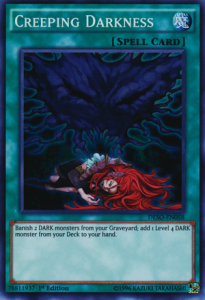 DARK Support
DARK Support
- Creeping Darkness – With so many DARK monsters, who doesn’t want a free DARK searcher. Grabbing Duke Shade, Chupacabra, Skyblaster, or even Tiamaton can be gamechanging with the potential advantage they offer.
- Deck Devastation Virus – Virus is good. Goodbye lots of weak monsters. ‘Nuff said.
- Grinning Grave Virus – With so many strong DARK monsters, you can really rip a ton of cards out of your opponents deck. While they can activate their effects on future turns, certain decks may find it difficult to recover with so many of their cards out of the deck.
- Eradicator Epidemic Virus – The ‘you can’t play your game’ Virus against Striker, Altergeist, and many other decks.
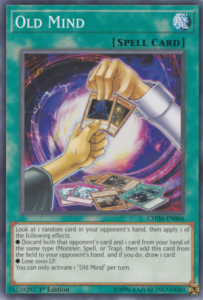 Draw Power
Draw Power
- Allure of Darkness – DARK decks love this card, and Danger is no exception. There is a risk of digging to your supporting spells and traps too fast and lower your Danger count in hand to play with, so that is a risk you should be wary of.
- Trade-In – With 3 different Level 8 Danger monsters, you can easily run Trade-In alongside the Dangers. They also benefit from being discarded, so extra card advantage for you. The downside is the current prevelence of Ash Blossom, which can make an activation of Trade-In at best an even trade of card advantage.
- Old Mind – This is a wacky card recently released to the TCG, but it can be very effective in Dangers. With so many decks running high monster counts, you have a pretty good chance of resolving its first effect properly to discard an opponents monster in hand, as well as triggering your own Danger, as well as drawing a new card to replace Old Mind. Again, it’s just another option to consider as a tech.
- Card Destruction – This card was meant for discard loving decks. But it also helps the opponent. So you have to be extremely smart and tactful when you activate it, as you may inadvertently trigger your opponents effects or help them setup their GY easily.
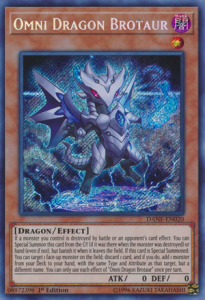 Discarders
Discarders
- Omni Dragon Brotaur – This is a great option that discards a card, searches a card to replace itself. The other major benefit is that it can be discarded itself, since it can also summon itself from the GY with its effect. Great additional way to trigger Dangers during the opponent’s turn.
- Slash Draw – Oh man, the days of the Slash Draw FTK may be scary to some, but the one copy that you can still run today can still have an impact. While it discards and draws, it also lets you completely setup your GY with the cards you want in it – recovering extra Beginning of the End or Danger Zone can allow you to streamroll advantage into victory.
- Paleozoic Dinomischus – One of the better discard to banish trap options out there, as the discard is not a cost. This means that it can trigger both your Dark Worlds and Dangers, also if your opponent negates it, you did not just discard as a cost for no reason!
- Twin Twisters – Discard? Check. Backrow control? Check.
 Recovery
Recovery
- Fish and Swaps – With both Nessie and Ogopogo being types recoverable by this spell, I’m convinced this is a sleeper power card for the theme. If you happen to trigger a Danger as well when activating this, that’s an immediate +1 with the potential for +2 later in the turn. AMAZING.
- Monster Reincarnation – Switch out a Danger for another monster in GY, trigger the danger, abuse the monster you get back, profit. Works great with limited cards like Skyblaster that offer you immense advantage when summoned.
- D.D.R. – Different Dimension Reincarnation – Recovery from the banished zone, also triggers your Dangers, so cool.
[Math 3 warning]
Card Design with a Splash of Game Theory
Let’s take the math piece of this article a step beyond simple card economy and get more strategic. For the majority of archetypes in the game, there are primarily two styles of design – let’s denote them as linear and non-linear decks. Linear decks are ones that are centered around a core set of plays, the rest of the deck is designed to make that core play happen as often as possible or to maximize the advantage in game state from doing so. A good example of this is Orcust – at the end of the day, you want to get Harp into the GY so you can begin the chain of Orcust effects. Sure, your end board can vary depending on if you want to go into Topologic, or sit on your Galatea to ensure that you have a live Crescendo, but outside of that, much of the path is the same. Compare that to a deck like Sky Striker, where your plan constantly changes because you can arrange your resources at will each turn. Sure, you want to always end on a Striker link with a Raye in GY, but the rest of your setup will change. This is an example of a non-linear deck. Now add Dangers to the mix and you actually can enable archetypes to switch between these two categories.
 In the field of game theory in mathematics, there are many descriptions for different types of games, but the one I want you to think about now is symmetric versus asymmetric games. Wikipedia has an understandable definition for this concept: “A symmetric game is a game where the payoffs for playing a particular strategy depend only on the other strategies employed, not on who is playing them.” As we’ve discussed earlier, the choice of the Danger you reveal first dictates the risk vs. reward paradigm of how the rest of your plays will operate. Thus, every Danger deck is inherently an asymmetric game, because it depends on who is playing them. This is the case for many non-linear decks, as the player (or duelist in this case), determines how they can leverage their deck to try and win a duel. On the other hand, matches between two linear decks can be quite symmetric – yes, a player can influence the outcome by misplaying, but if one major play chain is the main goal of each player, it is essentially a solved game, only affected by the randomness of the opening hands.
In the field of game theory in mathematics, there are many descriptions for different types of games, but the one I want you to think about now is symmetric versus asymmetric games. Wikipedia has an understandable definition for this concept: “A symmetric game is a game where the payoffs for playing a particular strategy depend only on the other strategies employed, not on who is playing them.” As we’ve discussed earlier, the choice of the Danger you reveal first dictates the risk vs. reward paradigm of how the rest of your plays will operate. Thus, every Danger deck is inherently an asymmetric game, because it depends on who is playing them. This is the case for many non-linear decks, as the player (or duelist in this case), determines how they can leverage their deck to try and win a duel. On the other hand, matches between two linear decks can be quite symmetric – yes, a player can influence the outcome by misplaying, but if one major play chain is the main goal of each player, it is essentially a solved game, only affected by the randomness of the opening hands.
So let me roll this concept back into my initial claim that Dangers let you delineate a strategy. By playing a Danger engine in any deck, you are choosing to insert player controlled randomness into the duel. Sure, you can’t control what is discarded when you activate one of their effects. But you do get to control the probabilities of coming out ahead. Think to the example of a Salamangreat deck playing a small Danger engine. What your opponent chooses for you to discard will give you options to continue forward in the duel with your opening plays. Does this mean that every deck should play Dangers? No, that’s not my claim at all. What I hope you get out of this is that Dangers are designed to push other themes further – think of them as an extender for archetype potential if you are familiar with the concept of extenders in your deck. That’s what makes the theme have such neat card design – its impact on the rest of the game.
While this entire segment may not seem all that math heavy – this may just be the most in-depth math section in here. I personally define mathematics as a field where you try to find patterns to determine the truth of things. But beyond my definition, it is commonly accepted that logic is just a subdiscipline of mathematics. And since I’ve been working through a logical argument for the classification of Dangers to the observed categories of archetypes, we’ve just been doing math. Hopefully if you are someone who has taken the time to read these sections, you’ll start to realize that math can be a lot more than just numbers, formulas, and homework – it actually can give pretty neat insight into a lot of different fields. Even Yu-Gi-Oh card design.
[Math 3 over]
Conclusion:
The Danger! archetype has a ton of potential with so many different archetypes. It’s theme is also unique, drawing upon the cryptids of legend to make your opponent search for the hidden monsters. It has so much synergy with other archetypes and themes, everything from Blue-Eyes to Fur Hire. Lastly, it is just freaking cool to actually interact with your opponent. I dont know about you, but Yu-Gi-Oh is just much more fun that way! Anyways, hopefully the math included in the article didn’t fry your brain too much, but I’ll be back soon with another article! Thanks for reading!
Reminder, I also take suggestions for future CDS articles! I really want to see some input from you! If you wish to see a CDS article about the archetype, theme, or strategy you love, feel free to private message me on the YGOrg Discord server, the YGOrganization Forums, or just post a comment in response to this article on our Facebook page with your ideas to keep under consideration! On most YGO-related communities my username is Quincymccoy, so feel free to reach out.


